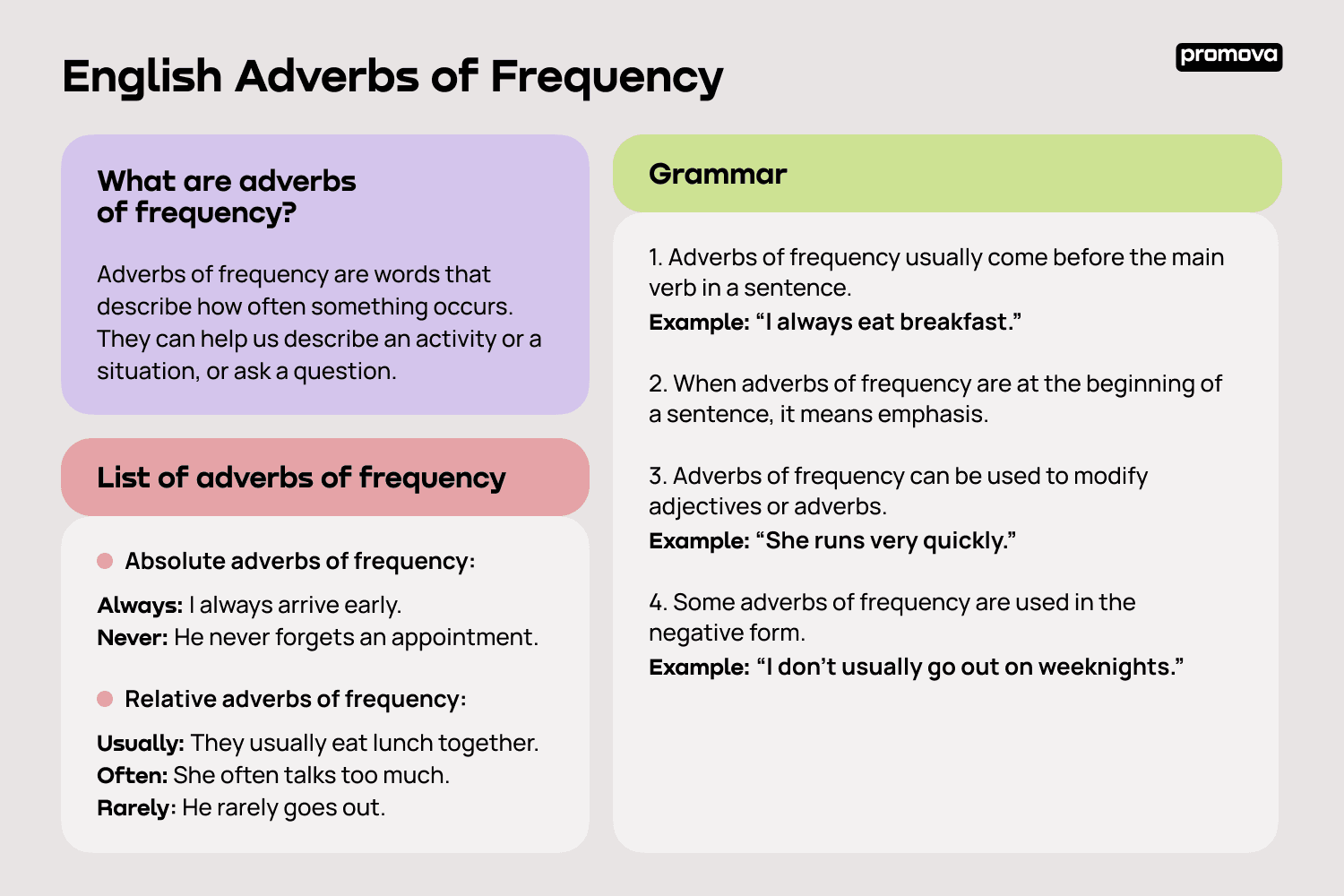English adverbs of frequency
Contents
We use adverbs of frequency to answer questions like “How often?”, “How much?”, and “How many times?”. They're an important part of English grammar and can be used in a variety of ways. In this reference, we will look at frequency adverbs in English, explore examples, find out how to use them in sentences, and see common mistakes to avoid.
What are Adverbs of Frequency?
Adverbs of frequency are words that describe how often something occurs. They can help us describe an activity or a situation, or ask a question. Adverbs of frequency usually come up in the present or past tense, but they can also be used in the future sometimes. For example, "I always go running on Sundays" in the present tense can become "I will be running daily starting next year" in the future.
Adverbs of frequency are divided into two main categories: absolute adverbs and relative adverbs. Absolute adverbs describe how often something happens in absolute terms, such as “always” or “never”. Relative adverbs describe how often something happens in relation to something else, such as “regularly” or “occasionally”.
Adverbs of frequency can also be used to modify adjectives or adverbs. For example, “very” can modify an adjective or adverb, as in “very often” or “very quickly”.
List of Adverbs of Frequency
Adverbs of frequency are divided into two main categories: absolute adverbs and relative adverbs. There are only two absolute adverbs of frequency:
- Always
- Never
And here is a list of relative adverbs of frequency:
- Usually
- Often
- Sometimes
- Seldom
- Rarely
Adverbs of frequency can also be used to modify adjectives or adverbs. For example, “very” is an adverb of frequency that is used to modify an adjective or adverb, as in “very often” or “very quickly”.
Adverb of Frequency Examples
Adverbs of frequency are used to answer questions like “How often?”, “How much?”, and “How many times?”.
You can use them to describe an activity or a situation, or to ask a question. For example, to find out how often someone goes to the gym, you can ask “How often do you go to the gym?”.
You can also modify adjectives or adverbs. For example, you can say “She runs very quickly”, where “very” is an adverb of frequency that is used to modify the adverb “quickly”.
Here are 5 more examples for your reference:
- I always arrive early.
- He rarely goes out.
- She often talks too much.
- They usually eat lunch together.
- He never forgets an appointment.
2
Adverb of Frequency Grammar
There are some rules that you should be aware of in your adverb telling frequency.
Firstly, adverbs of frequency usually come before the main verb in a sentence. For example, in the sentence “I always eat breakfast”, the adverb “always” comes before the main verb “eat”.
Secondly, when adverbs of frequency are at the beginning of a sentence, it means emphasis. For example, you would say “Never forget your anniversary” instead of “You never forget your anniversary” to entirely change the meaning of the sentence.
Adverbs of frequency can be used to modify adjectives or adverbs. For example, you can say “She runs very quickly”, where “very” is an adverb of frequency that is used to modify the adverb “quickly”.
Finally, some adverbs of frequency are used in the negative form. For example, you can say “I don't usually go out on weeknights”, where the word “usually” is in the negative form.
Common Mistakes
Avoid using the wrong adverbs in your sentences. For example, if you want to say that you never skip breakfast, don't say “I usually eat breakfast”, because the adverb “always” is more appropriate for an absolute activity.
Another mistake is to use adverbs of frequency in the wrong tense. For example, to say “I always eat breakfast”, you should not use the present perfect tense (“I have always eaten breakfast”).
Placement is also important. In the same example “I always eat breakfast”, you should never put the adverb after the verb (“I eat always breakfast”). In addition, "Always eat breakfast" with the adverb at the beginning of the sentence turns into a command instead of a statement.

Summary
Adverbs of frequency are words that describe how often something occurs. They are used to answer questions like “How often?”, “How much?”, and “How many times?”. Adverbs of frequency are divided into two main categories: absolute adverbs and relative adverbs. They can also be used to modify adjectives or adverbs.
Be aware of the grammar rules when using adverbs of frequency and to avoid common mistakes. With practice, you will be able to freely use them in your own sentences and become more fluent.
Comments